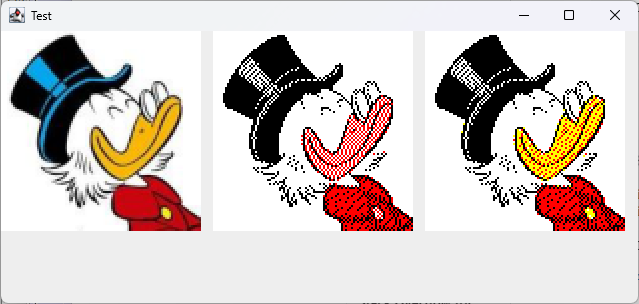Use image.getRGB(x, y) and image.setRGB(x, y, color) and use the pseudocode from the wikipedia article. Note that code on the wiki does not say how to "subtract", "add" and "multiply" colors. (The T3 class below handles "color" manipulation.)
The code below will produce this screenshot:
![screenshot]()
class Test {
private static BufferedImage floydSteinbergDithering(BufferedImage img) {
C3[] palette = new C3[] {
new C3( 0, 0, 0),
new C3( 0, 0, 255),
new C3( 0, 255, 0),
new C3( 0, 255, 255),
new C3(255, 0, 0),
new C3(255, 0, 255),
new C3(255, 255, 0),
new C3(255, 255, 255)
};
int w = img.getWidth();
int h = img.getHeight();
C3[][] d = new C3[h][w];
for (int y = 0; y < h; y++)
for (int x = 0; x < w; x++)
d[y][x] = new C3(img.getRGB(x, y));
for (int y = 0; y < img.getHeight(); y++) {
for (int x = 0; x < img.getWidth(); x++) {
C3 oldColor = d[y][x];
C3 newColor = findClosestPaletteColor(oldColor, palette);
img.setRGB(x, y, newColor.toColor().getRGB());
C3 err = oldColor.sub(newColor);
if (x+1 < w) d[y ][x+1] = d[y ][x+1].add(err.mul(7./16));
if (x-1>=0 && y+1<h) d[y+1][x-1] = d[y+1][x-1].add(err.mul(3./16));
if (y+1 < h) d[y+1][x ] = d[y+1][x ].add(err.mul(5./16));
if (x+1<w && y+1<h) d[y+1][x+1] = d[y+1][x+1].add(err.mul(1./16));
}
}
return img;
}
private static C3 findClosestPaletteColor(C3 c, C3[] palette) {
C3 closest = palette[0];
for (C3 n : palette)
if (n.diff(c) < closest.diff(c))
closest = n;
return closest;
}
public static void main(String[] args) throws IOException {
final BufferedImage normal = ImageIO.read(new URL("http://upload.wikimedia.org/wikipedia/en/2/24/Lenna.png")).getSubimage(100, 100, 300, 300);
final BufferedImage dietered = floydSteinbergDithering(ImageIO.read(new URL("http://upload.wikimedia.org/wikipedia/en/2/24/Lenna.png"))).getSubimage(100, 100, 300, 300);
JFrame frame = new JFrame("Test");
frame.setLayout(new GridLayout(1, 2));
frame.add(new JComponent() {
@Override
protected void paintComponent(Graphics g) {
super.paintComponent(g);
g.drawImage(normal, 0, 0, this);
}
});
frame.add(new JComponent() {
@Override
protected void paintComponent(Graphics g) {
super.paintComponent(g);
g.drawImage(dietered, 0, 0, this);
}
});
frame.setDefaultCloseOperation(JFrame.EXIT_ON_CLOSE);
frame.setSize(400, 400);
frame.setVisible(true);
}
static class C3 {
int r, g, b;
public C3(int c) {
Color color = new Color(c);
this.r = color.getRed();
this.g = color.getGreen();
this.b = color.getBlue();
}
public C3(int r, int g, int b) {
this.r = r;
this.g = g;
this.b = b;
}
public C3 add(C3 o) {
return new C3(r + o.r, g + o.g, b + o.b);
}
public C3 sub(C3 o) {
return new C3(r - o.r, g - o.g, b - o.b);
}
public C3 mul(double d) {
return new C3((int) (d * r), (int) (d * g), (int) (d * b));
}
public int diff(C3 o) {
return Math.abs(r - o.r) + Math.abs(g - o.g) + Math.abs(b - o.b);
}
public int toRGB() {
return toColor().getRGB();
}
public Color toColor() {
return new Color(clamp(r), clamp(g), clamp(b));
}
public int clamp(int c) {
return Math.max(0, Math.min(255, c));
}
}
}



